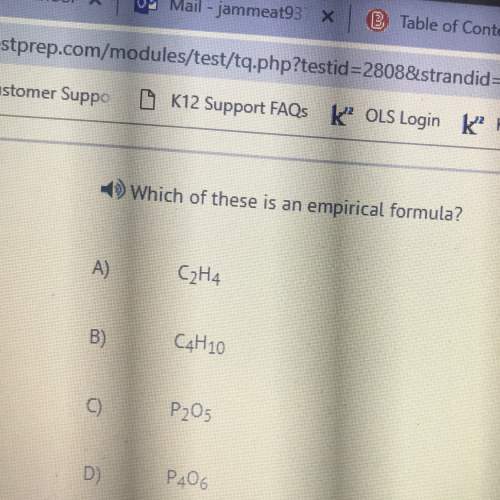
Chemistry, 24.11.2021 21:40 emmaguentherp3hjd3
Step 1: Gather materials and necessary information. a) You will be provided with these initial materials: 2 plastic resealable bags 3–5 "000" size empty gelatin capsules One 10 mL graduated cylinder to measure purified or distilled water 5 mL distilled water 1 g calcium chloride 1 Fahrenheit or Celsius thermometer 1 funnel Clock or stopwatch b) Make sure you use the materials given only for reference purposes in Steps 1 and 2 to help you with ideas in the design phase. Building the device does not occur at this point and any materials you alter or destroy will not be replaced. c) Be sure to organize your materials and make sure that the chemicals are handled safely. d) Do not allow substances to mix until the testing phase begins. e) Be sure you have paper and a pen or pencil to record data before, during, and after the testing phase of the project. This data will be reported in your final report. f) The reaction that will be used is the dissolving

Answers: 2
Another question on Chemistry

Chemistry, 21.06.2019 14:20
Calculate the enthalpy of the following reaction: 4 b (s) + 3 o2 (g) → 2 b2o3 (s) given the following pertinent information: (a) b2o3 (s) + 3 h2o (g) → 3 o2 (g) + b2h6 (g), δhoa = +2035 kj (b) 2 b (s) + 3 h2 (g) → b2h6 (g), δhob = +36 kj (c) h2 (g) + latex: \frac{1}{2} 1 2 o2 (g) → h2o (l), δhoc = −285 kj (d) h2o (l) → h2o (g), δhod = +44 kj
Answers: 3

Chemistry, 22.06.2019 07:50
Many reactions take place in aqueous solution. when potential reactants are mixed, a reaction will occur if there is some driving force that favors the formation of products. it is often convenient to categorize reactions in terms of these driving forces: precipitate formation, in which an insoluble solid is formed, weak electrolyte formation, as in a neutralization reaction involving water, or transfer of electrons, as in a redox reaction. these reactions can be represented by full molecular equations, which contain all species in the reaction mixture, or by net ionic equations, which show only the species that actually undergo a change. the latter does not contain the spectator ions, which do not undergo a net change or do not take part in the reaction. part a when the following two solutions are mixed: k2co3(aq)+fe(no3)3(aq) the mixture contains the ions listed below. sort these species into spectator ions and ions that react. drag the appropriate items to their respective bins. view available hint(s) spectator ions ions that react part b what is the correct net ionic equation, including all coefficients, charges, and phases, for the following set of reactants? assume that the contribution of protons from h2so4 is near 100 %.ba(oh)2(aq)+h2so4(aq)→ express your answer as a chemical equation. view available hint(s) nothing provide feedback
Answers: 3

Chemistry, 22.06.2019 10:00
How many mmols of tris-hcl are there in 100 ml of a 100 mm tris-hcl buffer solution at ph 8.1? note that the 100 mm refers to the sum of tris and tris-hcl concentrations?
Answers: 3

Chemistry, 22.06.2019 12:00
Most materials are not magnetic because their magnetism has worn off. their magnetic domains are arranged randomly. they lack magnetic fields. earth’s heat has destroyed their magnetism.
Answers: 1
You know the right answer?
Step 1: Gather materials and necessary information. a) You will be provided with these initial mater...
Questions


Engineering, 21.07.2021 08:30


Social Studies, 21.07.2021 08:30

Geography, 21.07.2021 08:50

Mathematics, 21.07.2021 08:50


History, 21.07.2021 08:50

Mathematics, 21.07.2021 08:50



Chemistry, 21.07.2021 08:50


English, 21.07.2021 08:50


Mathematics, 21.07.2021 08:50


Mathematics, 21.07.2021 08:50





